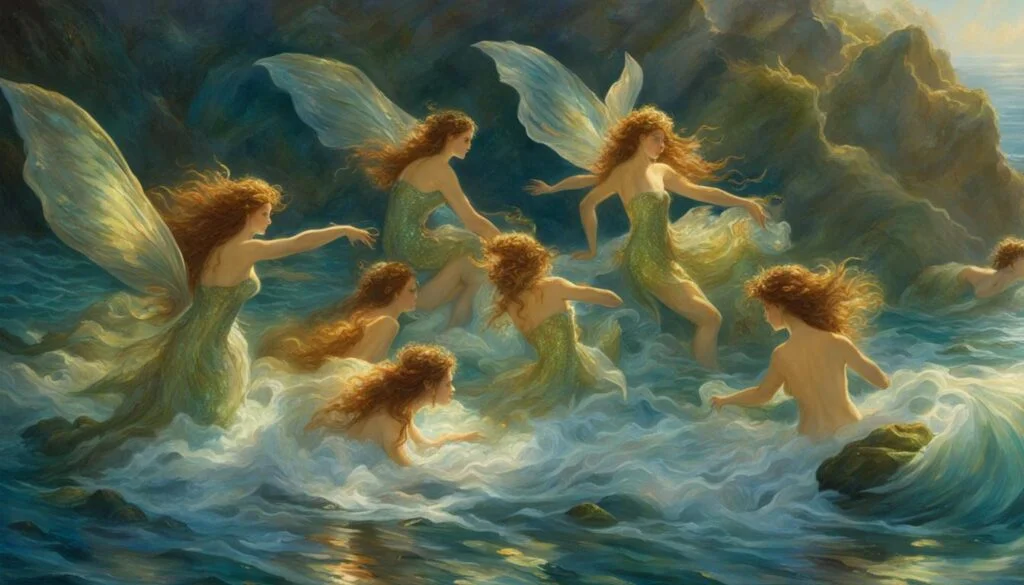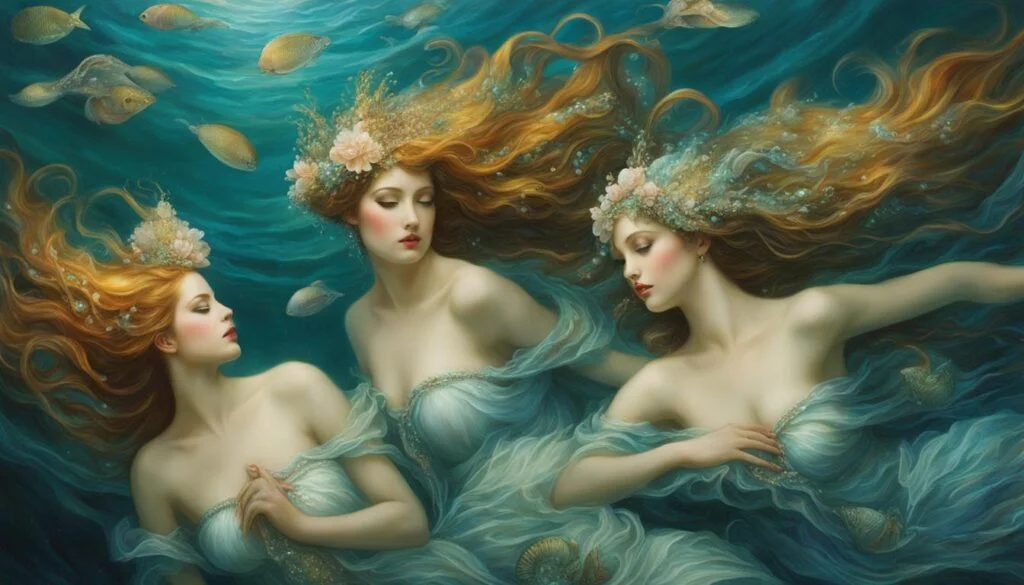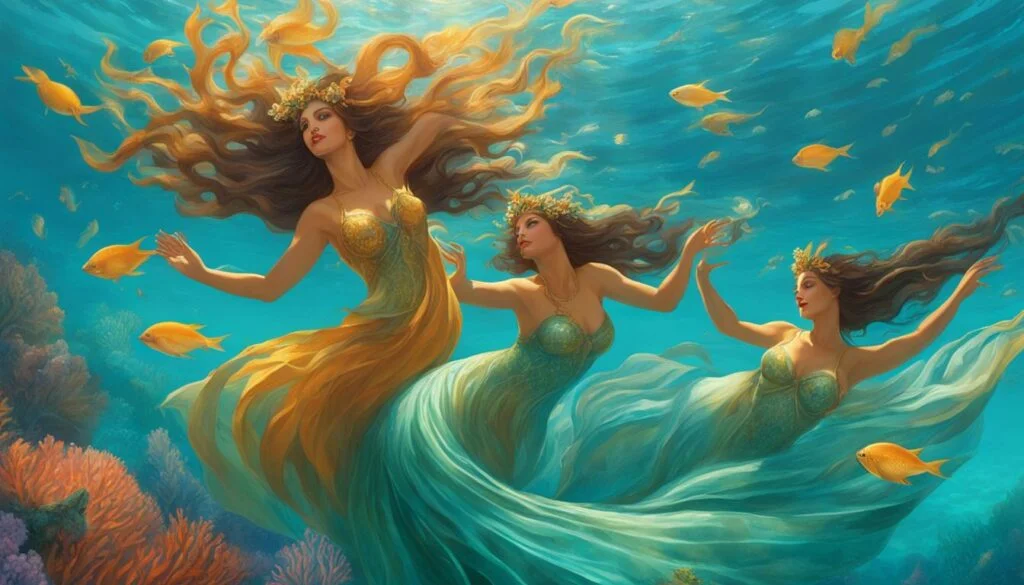In Greek mythology, the Nereids are sea nymphs, the 50 daughters of Nereus and Doris. They are known for their association with the sea and their close relationship with Poseidon. The name “Nereid” is derived from their father’s name, Nereus, and they are often depicted as beautiful, helpful, and kind to sailors.
Key Takeaways:
- The Nereids are sea nymphs in Greek mythology, the daughters of Nereus and Doris.
- They are closely associated with the sea and have a strong relationship with Poseidon.
- The name “Nereid” is derived from their father’s name, Nereus.
- Nereids are often depicted as beautiful, helpful, and kind to sailors.
- They play significant roles in mythological stories and are revered for their grace and enchanting presence.
The Mythological Origins of Nereids
The Nereids, enchanting sea nymphs in Greek mythology, trace their lineage back to Nereus, known as the ‘Old Man of the Sea,’ and the Oceanid Doris. Born in the mystical depths of the Aegean Sea, these divine beings resided in a breathtaking golden palace beneath the waves. As the daughters of Nereus, the Nereids shared a deep connection with the sea, often seen frolicking, dancing, and singing with their father and other captivating sea creatures.
Renowned for their beauty and benevolence, the Nereids played significant roles in various mythological stories. They served as protectors of sailors and were praised for their kindness and protection in times of peril. Revered as ethereal and gentle spirits of the sea, they embodied the grace and mystique associated with nymphs in Greek mythology.
The Splendor of the Nereid’s Origin
The Nereids’ origin lies deep within the Aegean Sea, a place of tranquil beauty and profound mystery. Born into a world of shimmering waters and boundless depths, they inhabited a magnificent golden palace hidden from mortal eyes. It is within this realm that these celestial nymphs, with their enchanting voices and captivating presence, forged their everlasting bond with the sea.
In the embrace of their oceanic home, the Nereids danced and frolicked, their melodies harmonizing with the ebb and flow of the tides. They reveled in the company of their father Nereus, engaging in playful exchanges with the sea creatures who inhabited their aqueous domain.
As the embodiment of the sea’s allure, the Nereids held a revered place in Greek mythology. Their origin story serves as a testament to their captivating beauty and profound connection to the mysteries of the ocean.
The Characteristics of Nereids

Nereids, the enchanting sea nymphs of Greek mythology, possess a range of distinguishing traits that set them apart. Known for their beauty, grace, and captivating voices, these ethereal beings captivate all who encounter them.
Adorned in flowing white silk robes embellished with delicate golden trim, Nereids emanate an air of elegance and mystique. They wear wreaths made of vibrant red coral on their heads, symbolizing both their connection to the sea and their regal status.
Apart from their physical allure, Nereids possess remarkable abilities in the underwater realm. They are skilled swimmers, effortlessly navigating the Aegean Sea as if it were their home. Their proficiency in the water allows them to aid sailors in their voyages and calm the turbulent seas with their mere presence.
In addition to their aquatic prowess, Nereids are believed to possess the gift of prophecy. Endowed with this ability inherited from their father Nereus, these sea nymphs hold deep insights into the past, present, and future.
Furthermore, Nereids share a close relationship with the gods and goddesses of Greek mythology, with Poseidon, Amphitrite, and Thetis being particularly significant figures in their lives. As divine companions, they serve as loyal attendants and emissaries, ensuring harmonious connections between the mortal and immortal realms.
There is no doubt that the Nereids’ unique blend of beauty, grace, otherworldly abilities, and close association with the divine makes them extraordinary beings in the realm of Greek mythology.
Nereid Characteristics:
- Beauty and grace
- Enchanting voices
- White silk robes with golden trim
- Wreaths of red coral
- Skilled swimmers
- Calming presence for sailors
- Gift of prophecy
- Close relationship with gods and goddesses
Famous Nereids in Greek Mythology
In the rich tapestry of Greek mythology, several Nereids stand out as prominent figures. These mythical sea nymphs, known for their beauty and enchanting nature, played significant roles in various mythological stories, capturing the imaginations of ancient Greeks and continuing to intrigue us today.
Thetis
Thetis, a renowned Nereid, was the mother of the mighty Greek hero Achilles. Known for her grace and wisdom, Thetis played a pivotal part in the Trojan War, seeking to protect her son from harm.
Amphitrite
Amphitrite, the wife of Poseidon, ruler of the seas, was revered as the queen of the Nereids. She is often depicted as a powerful and regal figure, with a trident in her hand and surrounded by sea creatures. Amphitrite was also the mother of Triton, a sea deity.
Galatea
Galatea was a captivating Nereid who became the love interest of Cyclops Polyphemus. Their ill-fated romance unfolded in the famous story of “Polyphemus and Galatea,” showcasing the complex relationships between gods, nymphs, and mortals.
Psamathe
Psamathe, another notable Nereid, was the mother of Phocus, Theoclymenus, and Theonoe. Her story intertwines with the adventures of her children as they navigate the trials and tribulations of Greek mythology.
These remarkable Nereids left an indelible mark on Greek mythology and continue to be celebrated in art, literature, and popular culture. Their captivating stories serve as a reminder of the enduring allure and influence of these mythical sea nymphs.
Nereids in Art and Iconography

Nereids, the enchanting sea nymphs of Greek mythology, have long been a subject of fascination in ancient Greek art. These beautiful young women, often depicted as partially or completely nude, were portrayed riding sea creatures like dolphins or tritons, symbolizing their close connection to the ocean.
Nereids were not only featured individually but also appeared in scenes depicting mythological stories. One such example is the portrayal of the Argonauts’ legendary journey, where the Nereids were believed to have aided and protected the heroes during their perilous voyage.
Another famous representation of Nereids is in the depictions of the Trojan War, where they played a significant role in supporting and guiding warriors like Achilles in their exploits and battles. These artistic depictions served as a visual celebration of the power, beauty, and presence of these celestial beings in Greek mythology.
The captivating allure of Nereids in art was not limited to paintings alone. They were also favored subjects in sculpture, adorning numerous temples, sanctuaries, and public spaces. Their statues stood as testaments to their divinity and served as objects of admiration and reverence.
In addition to sculptures, Nereids were often featured in mosaics and frescoes, where their delicate features and mesmerizing presence were captured in intricate detail. These artistic representations showcased the belief in the existence of these benevolent sea nymphs and their relationship with gods and goddesses.
The artistic portrayal of Nereids in ancient Greece and the Roman Empire continues to captivate and inspire us today. Their mesmerizing beauty and connection to the sea evoke a sense of wonder and enchantment. Through art, we can immerse ourselves in the mythical realm of Nereids and appreciate the rich symbolism and cultural significance they hold in Greek mythology.
Worship and Symbolism of Nereids

In ancient Greece, Nereids were revered as benevolent goddesses of the sea, worshipped for their association with the calming and nurturing aspects of the ocean. It was believed that these divine beings would aid sailors in times of need, offering protection and assistance on their voyages.
Moreover, Nereids held a connection to the mysteries of Dionysus and Persephone, known for revealing divine knowledge to humans. This bestowed upon them an aura of wisdom and transcendent power.
The symbolism surrounding Nereids emphasized the beauty, grace, and immense power of the sea. They were often depicted as symbols of fertility and abundance, highlighting the life-giving qualities of the ocean.
The Importance of Nymphs in Greek Mythology

Nymphs played a significant role in Greek mythology. They were minor deities associated with nature, including forests, mountains, and bodies of water. Nymphs were believed to be the daughters of gods or other supernatural beings and were often depicted as beautiful young women. They were associated with specific natural features and had various roles, such as protectors of the environment or companions to gods and heroes.
These mythical nymphs embodied the essence of nature, representing its beauty and vitality. They were known for their close connection to the natural world and often served as symbols of fertility and abundance. Nymphs were revered for their enchanting presence and their ability to bring life and vibrancy to the natural landscapes they inhabited.
In Greek mythology, nymphs were believed to possess special powers and abilities. They were thought to have the power to heal, inspire, and even foretell the future. Their presence in the wilderness was seen as a source of inspiration for poets and artists, who sought to capture the magic and wonder of the natural world.
Throughout Greek literature and art, nymphs were often portrayed as ethereal beings, radiating beauty and grace. They were depicted as playful and lively, enjoying their existence in the realms they inhabited. Nymphs were frequently found in the company of gods and heroes, serving as both companions and muses.
The significance of nymphs in Greek mythology cannot be understated. They personified the harmony between humanity and nature, embodying the interconnectedness of all living beings. Nymphs represented the awe-inspiring power and beauty of the natural world, reminding humans of the importance of respecting and preserving the environment.
The image above depicts the enchanting presence of nymphs in Greek mythology. Their graceful forms and connection to nature are beautifully captured, showcasing their significance in ancient Greek culture.
The Etymology of the Term “Nereid”

The term “Nereid” is derived from the name of the Nereids’ father, Nereus. However, its exact origin and etymology are uncertain. Some theories suggest that it may be related to the Greek words for “hollow rock” or “low-lying.” Despite the unclear etymology, the term “Nereid” has become synonymous with the sea nymphs in Greek mythology.
The fascinating origin of the term “Nereid” adds to the allure and mystery surrounding these enchanting beings. As symbols of beauty and grace, the Nereids captivate us with their connection to the sea and their role in mythological stories. Their influence in ancient Greek culture and their lasting legacy in art, literature, and popular culture demonstrate the enduring fascination with these sea nymphs.
The Symbolic and Cultural Significance of Nereids

Nereids, the sea nymphs of Greek mythology, hold great symbolic and cultural value. Representing the beauty, grace, and power of the sea, these enchanting beings captured the imaginations of ancient Greeks. As embodiments of the alluring aspects of water, they evoked a sense of awe and wonder among the people.
These sea nymphs were closely associated with the natural forces of the sea. Admired for their beauty and kindness, Nereids occupied a revered place in Greek society. Their presence in myths, art, and worship highlighted the significance placed on the sea and its inhabitants in ancient Greek culture.
- Beauty and Grace: Nereids symbolized unparalleled beauty and grace. With their flowing white silk robes adorned with golden trim and wreaths of red coral, they embodied elegance and charm.
- The Power of the Sea: The Nereids represented the power and might of the sea. They possessed the ability to calm the seas and aid sailors in their voyages, imparting a sense of safety and protection.
- Inspiration and Artistry: The allure of Nereids inspired artists throughout history. From ancient sculptures and mosaics to modern-day interpretations, their depiction continues to captivate viewers and serve as a muse for creative expression.
Nereids were not just revered for their physical beauty; they were also greatly admired for their kind and nurturing nature. Their association with gods and goddesses, particularly Poseidon, Amphitrite, and Thetis, further emphasized their significance in Greek mythology.
The influence of Nereids extends beyond ancient Greek culture. Their symbolism and cultural significance continue to resonate in various forms of art, literature, and even popular culture. The enduring appeal of these sea nymphs serves as a testament to their timeless allure and the enduring fascination with the enchanting world of Greek mythology.
The Legacy of Nereids in Modern Culture

The influence of Nereids, the enchanting sea nymphs of Greek mythology, resonates in various facets of modern culture. Their captivating depictions in ancient art continue to inspire countless artists throughout history, infusing their works with the timeless themes of beauty, grace, and the awe-inspiring power of the sea.
In literature, the allure of Nereids permeates the pages of novels, poems, and mythological retellings. Their ethereal presence and connection to the water evoke a sense of enchantment and wonder, captivating readers with their charm and mystical qualities.
The captivating essence of Nereids also finds its way into the realm of music. Composers and songwriters draw inspiration from the mythology surrounding these sea nymphs, creating melodious compositions that convey a sense of the enchanting and mesmerizing nature of the ocean.
Furthermore, the influence of Nereids extends to the world of film, where their alluring and otherworldly depiction can be seen in cinematic masterpieces. From visually stunning underwater sequences to tales of mermaids and sea creatures, Nereids continue to captivate audiences, keeping the rich mythological tradition alive in contemporary storytelling.
In summary, the legacy of Nereids in modern culture is one of ongoing inspiration and fascination. Their depictions in art, literature, music, and film serve as enduring reminders of the enchanting world of Greek mythology and the enduring allure of these divine sea nymphs.
The Fascinating Tales of Nereids

The captivating and diverse stories and myths surrounding Nereids, the sea nymphs of Greek mythology, continue to intrigue and entertain audiences. These mythical beings have played significant roles in various legendary exploits and love affairs, leaving an indelible mark on the world of Greek mythology.
Nereids in Heroic Exploits
Throughout history, Nereids have been known to be instrumental in the heroic exploits of the Argonauts. These sea nymphs offered their guidance and protection to the brave adventurers on their quest for the Golden Fleece. With their mystical abilities and knowledge of the sea, the Nereids played a crucial role in the success of this daring endeavor.
Love Affairs with Gods and Mortals
The allure and charm of Nereids extended beyond their heroic involvements. These beautiful sea nymphs often found themselves entangled in passionate love affairs with gods and mortals alike. Whether it was their enchanting beauty or their irresistible allure, Nereids captivated the hearts of many. These love stories created an enticing tapestry within the realm of Greek mythology, showcasing the enduring appeal of the sea nymphs.
To illustrate their captivating tales and immerse yourself in the enchanting world of Nereids, take a moment to visualize their ethereal beauty in this artistic depiction:
- The story of Thetis, the beloved mother of the legendary hero Achilles, and her pivotal role in the Trojan War.
- The myth of Amphitrite, the wife of Poseidon and mother of Triton, and her journey from a shy sea nymph to a powerful goddess.
- The tragic tale of Galatea, who fell in love with the Cyclops Polyphemus, provoking the wrath of Poseidon.
- The story of Psamathe, the mother of Phocus, Theoclymenus, and Theonoe, and her struggles as a single mother in Greek mythology.
These tales and more offer a glimpse into the captivating and enduring mythology of Nereids, highlighting their significant role in Greek mythological narratives.
Conclusion
The Nereids, sea nymphs of Greek mythology, are captivating figures associated with the sea. Born from the union of Nereus and Doris, these 50 sisters were known for their beauty, grace, and deep connection to the sea. Their presence in mythological stories as the daughters of the sea and companions to gods and heroes highlighted their significance in Greek culture.
The legacy of the Nereids continues to resonate in various forms of art, literature, and popular culture. Their enchanting allure and mythical charm have inspired countless artists throughout history, with their depictions adorning sculptures, mosaics, and frescoes. Their stories and exploits have been retold in literature, music, and film, serving as a testament to the enduring fascination and appeal of Greek mythology.
As symbols of the sea’s beauty, grace, and power, the Nereids leave a lasting impression on those who hear their tales. Their role in ancient Greek society as nurturing and benevolent goddesses of the sea reflects the significance of the oceans in daily life. Whether they calmed the seas for sailors or unveiled divine knowledge, the Nereids served as a reminder of the natural forces and mysteries that shaped the world.
Through their rich mythology and cultural prominence, the Nereids continue to captivate and inspire audiences, keeping the enchanting world of Greek mythology alive for generations to come.
FAQ
What is a Nereid in Greek mythology?
In Greek mythology, a Nereid is a sea nymph, one of the 50 daughters of Nereus and Doris.
What are the characteristics of Nereids?
Nereids are known for their beauty, grace, and enchanting voices. They are skilled swimmers and have the power of prophecy. They are often depicted as helpful and kind to sailors.
Who are some famous Nereids in Greek mythology?
Some famous Nereids include Thetis, Amphitrite, Galatea, and Psamathe, who played significant roles in various mythological stories.
How were Nereids depicted in ancient Greek art?
Nereids were often depicted as beautiful young women, partially or completely nude, riding sea creatures such as dolphins or tritons. They were also shown in scenes of mythological stories.
What was the significance of Nereids in ancient Greek culture?
Nereids were worshiped and considered benevolent goddesses of the sea. They were associated with the calming and nurturing aspects of the sea and were believed to aid sailors in times of need.
What is the role of nymphs in Greek mythology?
Nymphs are minor deities associated with nature. They were often depicted as beautiful young women and had various roles, such as protectors of the environment or companions to gods and heroes.
What is the origin of the term “Nereid”?
The term “Nereid” is derived from the name of the Nereids’ father, Nereus, but its exact etymology is uncertain. It may be related to the Greek words for “hollow rock” or “low-lying.”
What is the symbolic significance of Nereids?
Nereids symbolize the beauty, grace, and power of the sea. They are associated with the enchanting and alluring aspects of water, representing the awe and wonder of the sea in Greek culture.
How are Nereids portrayed in modern culture?
The influence of Nereids can be seen in art, literature, and popular culture. Their depictions in ancient art have inspired countless artists throughout history, and their themes are echoed in various forms of media.
What are some fascinating tales involving Nereids?
Nereids are involved in numerous mythological stories, from the heroic exploits of the Argonauts to their love affairs with gods and mortals. Each Nereid has her own unique tale.




